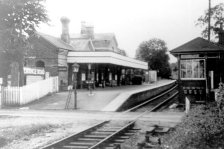The rising population and the consequent demand for land led to further piecemeal enclosure of Crawley Down and Copthorne Common, of which Squire‘s Cottage is an example, and with the parish church four miles away at Worth, a chapel was built on part of the Down in 1843. The need for houses led inevitably to a search for suitable brickearth and brickmaking began later in the decade on the site of the Royal Oak public house. So much of the common had been enclosed by this date that representations were made to the Earl of Chichester, the Lord of the Manor, to enclose all of Crawley Down. This was done in 1848. Within seven years the railway from Three Bridges to East Grinstead had been built. A dispute with the owner of the Grange coupled with the building of Rowfant station delayed a station at Crawley Down for five years, but the development of the brickworks required an efficient transport system. The effect of the opening of Grange Road Station was to attract several wealthy businessmen to the area who set up large establishments, particularly at Down Park and Tiltwood, both of which were built in the 1860s. The need for a local infrastructure for these houses and for the brickworks led to more building, and slowly a village began to emerge, principally along Bowers Place, Sandy Lane, Hophurst Lane and the Turners Hill Road.
The sale of the Grange Estate in 1931 opened up for development much of the land in the centre of the village between Station Road and the Turners Hill Road. After the Second World War, the closure of the brickworks, which once stretched from Tiltwood to Sandhill Lane, and of the railway, coupled with the dividing-up of many of the local estates and their large houses – all which had been factors in the village’s growth – made room for the building of Burleighwood and the expansion of Crawley Down in the 1970s and 80s.
Jeremy Hodgkinson
December 2005


